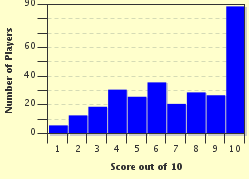Quiz Answer Key and Fun Facts
1. I need to pick out the glass I will be using for my panel, which is sold in sheets. There are multitudes of colors, textures, and thicknesses to choose from. I'm on somewhat of a budget, though. What color of glass will I want to try to avoid, because its gold content is the highest, typically making it the most expensive?
2. I must decide what method I'm going to use to assemble my stained glass panel, which is going to be an 8-inch-diameter circle with 2 yellow rosebuds in the center. The pattern is simple, but it does have a couple of very small pieces. What method should I use for its construction?
3. My stained glass pattern is called a "cartoon". I have drawn off 2 copies of the cartoon using carbon paper to make them identical in every way. One copy is on drawing paper; the other is on tagboard. What is tagboard?
4. Cutting the glass for a stained glass window is actually one of the easiest steps, especially with all the handy tools on the market. For the majority of the pieces, a simple, handheld glass cutter will suffice. Which one of these other tools is NOT used to cut or shape glass?
5. What sort of technique should be used to cut the glass pieces using a handheld glass cutter?
6. After cutting out all the glass pieces for a stained glass panel and assembling them on the foundation board to see how well they will fit together, the grinder is used to shape each piece so that it fits perfectly next to its neighboring pieces. The glass grinder is any stained-glass-maker's best friend...or worst enemy. It has a water reservoir, diamond grinding bit, and (hopefully) the face shield. If your stained glass instructor were to warn you before using the grinder, "Be careful...you can't grow glass!", what would that imply?
7. When a stained glass panel is done with foil, copper foil tape must be stuck onto the edges of the pieces that touch each other. This tape is what the solder adheres to. A small implement is used to smooth this metal tape onto the glass as flat and evenly as possible. What is this tool called?
8. When it is finally ready to solder the stained glass panel, all joints and seams are brushed with flux first. Flux causes the solder to adhere to the copper. If I had constructed my panel in lead, I would be using a 60/40 solder; a foil-constructed panel uses 50/50. What does 60/40 mean in this context?
9. While stained glass is beautiful to look at, it is messy to make. A nice bubble bath for me and my panel is warranted after dealing with the gooey flux, the lead residue, and the patina. After I clean my panel with warm, soapy water and then with Windex, what is the last thing I can do to give it a beautiful shine?
10. Marc Chagall (1887-1985) was a Russian-French artist, who worked with many mediums. He is especially noted for his stained glass windows, or "Chagall Windows". Where are his 12 windows, representing the 12 tribes of Israel, now?
Source: Author
mberry923
This quiz was reviewed by FunTrivia editor
WesleyCrusher before going online.
Any errors found in FunTrivia content are routinely corrected through our feedback system.

